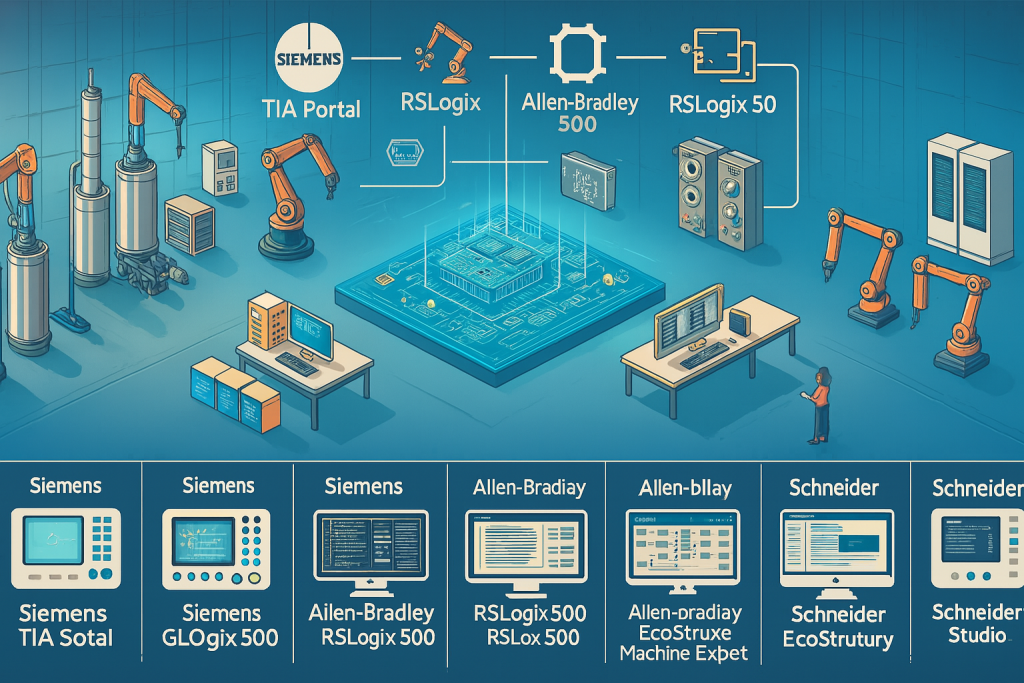 PLC Programming Software and Tools
PLC Programming Software and Tools
Programmable Logic Controllers (PLCs) are the backbone of modern industrial automation. To configure, program, test, and maintain these systems, engineers rely on specialized PLC programming software and tools. These platforms not only allow you to write logic but also enable simulation, monitoring, diagnostics, and integration with systems like SCADA, MES, and ERP. Selecting the right PLC programming software is a key step toward smooth commissioning, high availability, and long-term maintainability.

 1. Core Functions of PLC Programming Software
1. Core Functions of PLC Programming Software
Most PLC IDEs cover these functions end-to-end:
Logic Development: IEC 61131-3 languages such as Ladder Diagram (LD), Structured Text (ST), Function Block Diagram (FBD), Sequential Function Chart (SFC), and Instruction List (IL, legacy).
Simulation & Testing: Offline simulators validate logic before deployment, reducing commissioning time and risk.
Real-Time Monitoring: Live I/O, watch tables, scan-time profiling, diagnostics, and trend tracing.
Hardware Configuration: CPU type, I/O modules, fieldbus networks, and safety parameters.
Modern platforms also include integrated HMI design, motion control setup, IIoT connectivity, versioning, and cybersecurity controls.
 2. Leading PLC Programming Software Platforms
2. Leading PLC Programming Software Platforms
 A. Siemens TIA Portal (Totally Integrated Automation)
A. Siemens TIA Portal (Totally Integrated Automation)


- Single workspace for PLC, HMI, drives, and networks.
- Advanced trace, diagnostics, and safety programming.
- Native Profinet/Profibus and OPC UA interoperability.

 B. Allen-Bradley Studio 5000 (formerly RSLogix 5000)
B. Allen-Bradley Studio 5000 (formerly RSLogix 5000)


- IEC 61131-3 (LD, ST, FBD) plus robust motion profiles.
- EtherNet/IP diagnostics and online edits across the plant.
- FactoryTalk integration for SCADA/MES connectivity.

 C. Mitsubishi GX Works3
C. Mitsubishi GX Works3


- Supports iQ-R, iQ-F, FX, and L series PLCs.
- Drag-and-drop configuration; predictive maintenance and energy monitoring.
- Multi-language programming and motion functions.

 D. Schneider EcoStruxure Machine Expert (SoMachine)
D. Schneider EcoStruxure Machine Expert (SoMachine)


- Full IEC 61131-3 compliance and reusable function blocks.
- Secure remote diagnostics and cloud connectivity.
- Integration with energy analytics and monitoring platforms.

 E. Omron Sysmac Studio
E. Omron Sysmac Studio


- Built-in AI tools for predictive maintenance and anomaly detection.
- Tight vision system integration for quality inspection.
- Multi-axis motion and high-speed logic execution.

 3. Free and Open-Source PLC Programming Software
3. Free and Open-Source PLC Programming Software
A. OpenPLC
Best For: Learning PLC programming, hobby projects, research
Supports IEC 61131-3 languages
Runs on Arduino, Raspberry Pi, and industrial hardware
B. CODESYS
Best For: Multi-vendor PLC apps and cost-effective industrial solutions
Cross-platform development (Windows, Linux, Raspberry Pi)
Built-in simulation and debugging

 4. How to Choose the Right PLC Programming Software
4. How to Choose the Right PLC Programming Software
Industry & Application: Manufacturing, energy, pharma, F&B, or smart buildings?
PLC Compatibility: Verify brand, model, and firmware support.
Language Support: Ensure the IEC 61131-3 languages you need (LD, ST, FBD, SFC).
Simulation & Debugging: Offline simulation, trace, watch tables, diagnostics.
Integration: SCADA/MES, OPC UA/MQTT, historians, and data lakes.
Cost & Licensing: Community vs. professional licenses, support SLAs.
 5. Comparison Table – PLC Programming Software
5. Comparison Table – PLC Programming Software
| Software | Languages | Simulator | Online Edit | Integration | OS | License |
|---|---|---|---|---|---|---|
| Siemens TIA Portal | LD, FBD, SCL/ST | Yes | Yes | OPC UA, Profinet, HMI/Drives | Windows | Paid |
| Rockwell Studio 5000 | LD, FBD, ST | Yes | Yes | EtherNet/IP, FactoryTalk | Windows | Paid |
| Mitsubishi GX Works3 | LD, ST | Yes | Yes | iQ Platform, CC-Link | Windows | Paid |
| Schneider EcoStruxure Machine Expert | LD, FBD, ST | Yes | Yes | Modbus/TCP, OPC UA | Windows | Paid |
| Omron Sysmac Studio | LD, ST, FBD | Yes | Yes | EtherCAT, Vision, Robotics | Windows | Paid |
| CODESYS | All IEC 61131-3 | Yes | Yes | OPC UA, MQTT (plugins) | Windows, Linux | Free + Paid |
| OpenPLC | LD, ST, FBD | Yes | No | Arduino, RPi, Modbus | Windows, macOS, Linux | Free (Open Source) |
 6. The Future of PLC Programming Tools
6. The Future of PLC Programming Tools
Cloud Engineering: Remote development, deployment, and monitoring.
AI Diagnostics: Predictive maintenance and anomaly detection.
No-Code/Low-Code: Drag-and-drop logic for rapid prototyping.
Security by Design: Signed firmware, RBAC, network segmentation.
 Conclusion
Conclusion
PLC programming software is a complete engineering platform across the control lifecycle. Whether you build large-scale control with Siemens TIA Portal, commission high-speed packaging with Allen-Bradley Studio 5000, optimize energy-smart cells with Mitsubishi GX Works3, integrate hybrid systems with Schneider EcoStruxure Machine Expert, or prototype with CODESYS/OpenPLC, the right choice improves uptime, scalability, and total cost of ownership.

 PLC Programming Software and Tools
PLC Programming Software and Tools 1. Core Functions of PLC Programming Software
1. Core Functions of PLC Programming Software 2. Leading PLC Programming Software Platforms
2. Leading PLC Programming Software Platforms A. Siemens TIA Portal (Totally Integrated Automation)
A. Siemens TIA Portal (Totally Integrated Automation) B. Allen-Bradley Studio 5000 (formerly RSLogix 5000)
B. Allen-Bradley Studio 5000 (formerly RSLogix 5000) C. Mitsubishi GX Works3
C. Mitsubishi GX Works3 D. Schneider EcoStruxure Machine Expert (SoMachine)
D. Schneider EcoStruxure Machine Expert (SoMachine) E. Omron Sysmac Studio
E. Omron Sysmac Studio 3. Free and Open-Source PLC Programming Software
3. Free and Open-Source PLC Programming Software Supports IEC 61131-3 languages
Supports IEC 61131-3 languages 4. How to Choose the Right PLC Programming Software
4. How to Choose the Right PLC Programming Software 5. Comparison Table – PLC Programming Software
5. Comparison Table – PLC Programming Software 6. The Future of PLC Programming Tools
6. The Future of PLC Programming Tools Cloud Engineering: Remote development, deployment, and monitoring.
Cloud Engineering: Remote development, deployment, and monitoring. No-Code/Low-Code: Drag-and-drop logic for rapid prototyping.
No-Code/Low-Code: Drag-and-drop logic for rapid prototyping. Conclusion
Conclusion